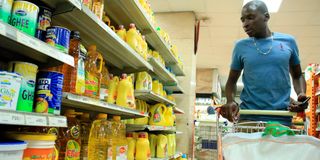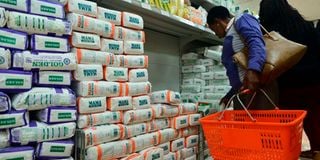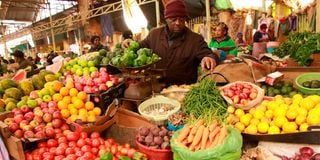Premium
Consumers dazzled by ‘new normal’ high cost of items that sticks to upward trend

A customer picks fruits at a supermarket in Nyeri.
What you need to know:
- An analysis of different commodity prices over the past five years shows that since 2019.
- Over the five years, fuel prices have doubled, while electricity increased by 78 per cent.
Marion Atieno (not her real name), a Nairobi resident, has vivid memories of 2019 as if it was yesterday.
Her memories, though, are largely not about the academic journey as she was in campus at the time.
They hover around what it used to cost her for upkeep, and how prices of some key items she has always used have changed rapidly, in a span of half a decade.
“I haven’t come to terms with the fact that a 16-piece pack of pads that I would use between Sh140 and Sh160 at the time now costs me close to Sh300, that my favourite body lotion on which I would spend Sh400 as a student is now costing me Sh670,” she opens up.
Admittedly, she observes a trend she has come to accept as part of ‘adulthood’ when commodity prices only know one way to go and that is up.

A shopper buying food stuffs at Naivas supermarket in Nairobi on December 31, 2019.
This has been the case for an eight-pack of toilet rolls that she would buy at about Sh280 but now spends more than Sh400 on it, her favourite Colgate toothpaste which cost about Sh200 but has now crossed Sh400, and Omo powder soap which retails close to Sh500 now, up from about Sh200 five years ago.
“So I decided that while I still prioritise my skincare routine, I might as well slow down on the extravagance I had when applying body lotion. Nowadays I apply it on ‘necessary’ body parts and don’t use as much toothpaste as I would back then,” Marion says.
And she is not alone in the learning curve on matters inflation, a subject many Kenyans have come to appreciate its impact on their livelihoods, particularly over the past four years since onset of Covid-19 that disrupted life as previously experienced.
Mr John Mwangi, also a resident of the capital city, recalls that five years ago, beef costing Sh300 was enough for himself and his girlfriend and they would have it in two meals. Not anymore.
“Just last week, I purchased Sh400 beef at my local butchery and almost asked the attendant whether he had the correct measurements. It was so little and I just had it in one meal,” he recalls.
This is his way of looking at inflation; how the quantity of commodities has been affected by inflation, what he gets for a particular amount, as compared to what he used to get a few years ago.
He reckons that a cake of bar soap that he would buy at Sh25 back around 2019 has doubled to Sh50 and that his bus fare from Thika to Murang’a Town is now Sh200, from Sh100 before Covid-19 struck in 2020.
Yet, like many other Kenyans, the two cannot fully comprehend the circumstances under which currently inflation is said to be “cooling down” when prices remain higher.
Last month, the Kenya National Bureau of Statistics (KNBS) official inflation figures showed that year-on-year inflation rate slowed down to 6.3 per cent, from 6.9 per cent in January.
The inflation has been coming down slowly, from a peak of 9.2 per cent in October 2022.
While slowing down, what the February inflation meant was that compared to a similar month in 2023, commodity prices increased by 6.3 per cent, overall.
Transport (10.8 per cent), alcoholic beverages, tobacco, and narcotics (8.7 per cent), and food and non-alcoholic beverages (6.9 per cent), contributed the most to the increase in prices, with electricity, carrots, paraffin, and sugar being items whose prices increased the most, over the one year.
“This means that in February 2024, the general price level was 6.3 per cent higher than that of February 2023,” KNBS noted.
This may have caused a sense of relief among policymakers charged with handling macroeconomic matters in the country, but many Kenyans cannot see why, with prices at stores remaining stubbornly high.
An analysis of different commodity prices over the past five years shows that since 2019, prices have gone up by between 40 per cent, to more than doubling for some items, a reflection of the feeling Marion, Mr Mwangi, and many Kenyans experience while shopping, many times never knowing how economics works.

Customers shop for subsidized maize flour at a Naivas Supermarket.
For instance, a two-kilogramme packet of sifted maize flour used for making Kenya’s staple, ugali, averagely cost Sh154.5 last month, 78 per cent up from its price of Sh86.6 in February 2019.
A kilogramme of Sukuma wiki and cabbage, mostly consumed alongside ugali, each cost 39 per cent more this year, than they did in 2019.
But it is the price of fuel and electricity that have always driven most of these commodity prices, due to their impact on production at different levels of the value chain.
Over the five years, petrol, paraffin, and diesel prices have doubled, while electricity consumed by households increased by 78 per cent, and that consumed by industries by 48 per cent.
“Back then, when I bought electricity tokens worth Sh500, I would get 27 units but that has come down to about 17 units. Matatu fares have also shot up by Sh20 to Sh80 at peak times. Interestingly, when they go up, they never come down again,” reckons a city commuter.
Over the past five years, prices of varied items — ranging from food commodities, detergents, transport services, and manufactured goods — have shot up, mainly caused by international trade disruptions and Covid-19 in 2020.
The way inflation works is that the national statistics body measures the average prices of a range of commodities that make the average consumers’ basket every month, and weighs them against the same commodities’ prices during a similar month the previous year.

Kariuki Gatiba, a trader, arranges groceries at Nyeri Town Market on May 3, 2023.
If during one month the prices have increased by a higher figure than the subsequent month, the inflation rate is said to have cooled down.
This means that while the prices have gone up, they have increased at a slower rate as compared to the rate in the previous month.
So in February when the inflation cooled down from 6.9 per cent in January, this did not imply that prices had come down, but rather that they went up, just at a slower pace.





